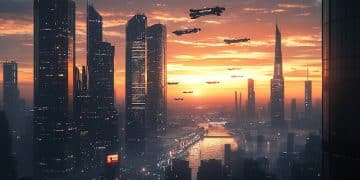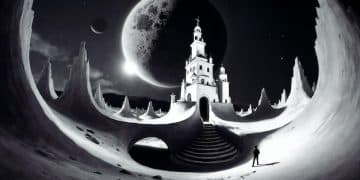The Western Reimagined: Modern Authors and the Subversion of Classic Tropes
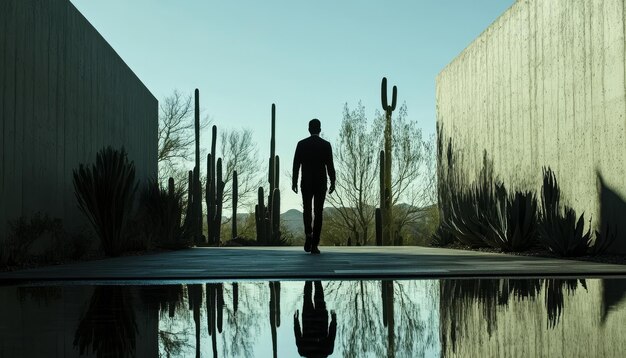
The Western reimagined by contemporary authors challenges traditional tropes by introducing diverse characters, complex narratives, and themes that reflect modern societal issues, offering a fresh perspective on the genre.
The allure of the Wild West, with its rugged landscapes and tales of cowboys and outlaws, has captivated audiences for generations. But what happens when modern authors take on this classic genre, challenging its conventions and offering a fresh perspective? The Western reimagined is precisely that: a contemporary exploration of the Western, one that subverts traditional tropes and introduces new voices and narratives.
From questioning historical accuracy to incorporating diverse characters and themes, these authors are reshaping our understanding of the American West. How are they achieving this, and what impact is it having on the genre? Let’s delve into the fascinating world of the Western reimagined.
What is the Western Reimagined?
The Western reimagined refers to a modern approach to the Western genre, where authors actively challenge and subvert classic tropes. This might involve re-examining historical events, introducing diverse characters who were historically marginalized, or exploring themes that resonate with contemporary social issues.
Challenging Traditional Western Tropes
Classic Westerns often feature stereotypical characters, such as the stoic cowboy, the damsel in distress, and the villainous Native American. Modern authors are dismantling these stereotypes, presenting more nuanced and realistic portrayals. They delve into the complexities of these characters, exploring their motivations and challenging the black-and-white morality often present in traditional Westerns.
Embracing Diversity and Inclusion
One of the most significant aspects of the Western reimagined is its commitment to diversity and inclusion. Authors are bringing to light the stories of women, people of color, and LGBTQ+ individuals who were historically excluded from the Western narrative. By amplifying these voices, they offer a more complete and accurate representation of the American West.
To recap, key characteristics defining the Western reimagined include:
- Challenging stereotypical characters and narratives.
- Incorporating diverse voices and perspectives.
- Addressing contemporary social issues within the Western setting.
- Re-examining historical events with a critical eye.
Ultimately, the Western reimagined breathes new life into a classic genre, making it more relevant and engaging for modern audiences. By questioning old conventions and embracing inclusivity, these authors are ensuring that the Western continues to evolve and resonate with readers for years to come.
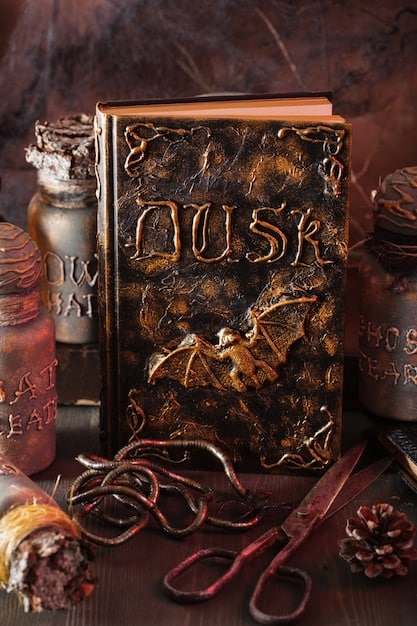
Modern Authors Leading the Charge
Several modern authors are at the forefront of this reimagining, each bringing their unique voice and perspective to the Western genre. These writers are not only skilled storytellers but also historians, activists, and cultural critics, using their work to challenge the status quo and offer new interpretations of the American West.
Cormac McCarthy: Deconstructing the Myth
While McCarthy’s works are not always considered strictly Westerns, his novels like “Blood Meridian” explore the brutal realities of the frontier, deconstructing the romanticized myth of the Wild West. His unflinching portrayal of violence and moral ambiguity challenges readers to confront the dark side of American expansion.
Louise Erdrich: Amplifying Native Voices
Louise Erdrich, a Native American author, brings a crucial perspective to the Western genre. Her novels often focus on the experiences of Native Americans, offering a counter-narrative to the traditional Western narrative that often marginalizes or demonizes indigenous peoples. Her work is a powerful testament to the resilience and strength of Native communities.
These authors, among others, are leading the way in:
- Providing more realistic and nuanced portrayals of the West.
- Challenging the traditional hero narrative.
- Exploring the darker aspects of American history.
- Giving voice to marginalized communities.
In conclusion, modern authors are actively reshaping the Western genre, offering a more complex and inclusive vision of the American West. Their daring reinterpretations invite people to critically examine the stories we tell ourselves about the past and present.
Thematic Shifts in the Western Reimagined
Beyond character and narrative, the Western reimagined also brings about significant thematic shifts. Modern authors are engaging with issues that were often ignored or glossed over in classic Westerns, such as environmentalism, social justice, and the psychological toll of violence.
Environmentalism: A New Frontier
Many modern Westerns grapple with the environmental consequences of westward expansion. Authors explore the impact of mining, logging, and other industries on the land, highlighting the delicate balance between human progress and environmental preservation. This theme adds a layer of complexity to the traditional Western narrative, prompting readers to consider the ethical implications of our relationship with nature.
Social Justice: Addressing Historical Inequities
The Western reimagined confronts the historical injustices perpetrated against marginalized groups, including Native Americans, African Americans, and women. Authors are shedding light on stories of resistance, resilience, and the ongoing struggle for equality. This thematic shift challenges the traditional Western’s often sanitized and biased portrayal of the past.
The Psychological Impact of Violence
Modern Westerns often delve into the psychological impact of violence on individuals and communities. Authors explore the trauma, moral ambiguity, and lasting consequences of violence, offering a more realistic and nuanced portrayal of the frontier experience. This theme challenges the traditional Western’s often glorified depiction of violence as a necessary tool for taming the Wild West.
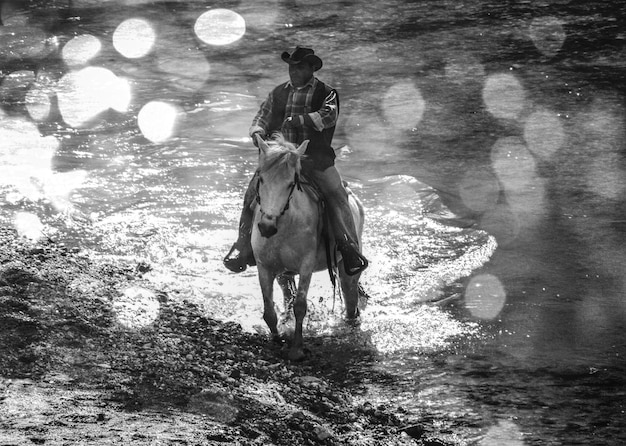
In short, The Western reimagined is tackling complex themes:
- Exploring the environmental impact of westward expansion.
- Addressing historical injustices and social inequities.
- Examining the psychological toll of violence.
- Challenging traditional notions of heroism and morality.
In conclusion, thematic shifts in the Western reimagined reflect a broader societal awareness of environmental concerns, social justice issues, and the psychological impact of violence. By confronting these complex themes, modern authors are making the Western genre more relevant and thought-provoking for contemporary audiences.
Impact on the Western Genre
The Western reimagined is not just a trend; it’s a transformative force that is reshaping the Western genre. By challenging traditional tropes, embracing diversity, and engaging with complex themes, these authors are ensuring that the Western remains relevant and engaging for modern audiences.
Expanding the Audience
By incorporating diverse characters and perspectives, the Western reimagined is attracting a broader audience. Readers who may have felt excluded or misrepresented by traditional Westerns are now finding stories that resonate with their experiences. This expansion of the audience is vital for the long-term health and vitality of the genre.
Encouraging Critical Engagement
The Western reimagined encourages critical engagement with the history and mythology of the American West. By challenging traditional narratives and prompting readers to question the status quo, these authors are fostering a more nuanced and informed understanding of the past. This critical engagement is essential for promoting social awareness and historical accuracy.
Inspiring New Creativity
The Western reimagined is inspiring new creativity within the genre. By pushing boundaries and experimenting with new forms and styles, authors are demonstrating the Western’s adaptability and potential for innovation. This infusion of creativity is ensuring that the Western remains a dynamic and evolving genre.
Ultimately, the Western reimagined has:
- Increased audience engagement with the genre.
- Sparked critical discussions about history and representation.
- Inspired new creative approaches to Western storytelling.
- Ensured the continued relevance of the genre in modern society.
The reimagining of the Western genre is not just about telling new stories; it’s about challenging old assumptions and fostering a more inclusive and thought-provoking understanding of the American West.
The Future of the Western
The future of the Western looks bright, thanks in large part to the ongoing efforts of authors who are reimagining the genre. As society continues to evolve, the Western will undoubtedly adapt and change, reflecting new perspectives and addressing contemporary issues.
Continued Diversification
The trend toward diversification will likely continue, with more authors from marginalized communities bringing their unique voices to the Western genre. This will result in a wider range of stories and perspectives, further enriching the landscape of the Western.
Exploration of New Themes
The Western will likely continue to explore new themes, such as climate change, technological innovation, and the changing nature of identity. These themes will add new layers of complexity to the Western narrative, making it even more relevant to modern audiences.
Experimentation with Form and Style
Authors will likely continue to experiment with form and style, pushing the boundaries of what a Western can be. This could involve incorporating elements of other genres, such as science fiction, fantasy, or horror, or experimenting with new narrative techniques.
To summarize, we can expect the Western genre to evolve with:
- Further inclusive and diversified representation.
- A broader range of modern themes and narratives.
- Innovation that challenges Western storytelling conventions.
- Continued audience engagement and critical discussion.
To conclude, the Western is poised for continued growth and evolution, ensuring that it remains a vital and compelling genre for generations to come. By embracing change and challenging tradition, the Western can continue to reflect the complexities and contradictions of the human experience.
| Key Point | Brief Description |
|---|---|
| 🔄 Challenging Tropes | Modern authors deconstruct classic Western stereotypes. |
| 🧑🤝🧑 Embracing Diversity | Including marginalized voices in Western narratives. |
| 🌎 Environmental Themes | Exploring effects of Western expansion on the land. |
| 🔮 Future Evolution | Western genre set to continue diversifying and evolving. |
Frequently Asked Questions
The Western reimagined involves modern authors breaking away from traditional Western tropes, presenting diverse characters, and addressing contemporary societal issues within the classic Western setting.
Cormac McCarthy deconstructs frontier myths, while Louise Erdrich amplifies Native voices. These are just two of numerous authors redefining the genre through their unique perspectives and narratives.
It confronts historical inequities experienced by marginalized groups and explores stories of resilience. This approach challenges biased portrayals and promotes a more inclusive understanding of Western history.
Themes include historical inequities, environmental preservation, and the psychological impact of violence. These complex themes help make the Western genre relevant and engaging for modern audiences.
It diversifies the audience, inspires new creativity, and encourages historical engagement. These efforts demonstrate the Western has the adaptability and potential for innovation needed to stay appealing.
Conclusion
The Western reimagined is a dynamic and evolving genre that challenges traditional tropes, embraces diversity, and explores complex themes. Modern authors are breathing new life into the Western, ensuring that it remains relevant and engaging for contemporary audiences.
As the Western continues to evolve, it will undoubtedly reflect new perspectives and address contemporary issues, ensuring that it remains a vital and compelling genre for generations to come. The transformation of the Western invites us all to look again at how we interpret the past.

